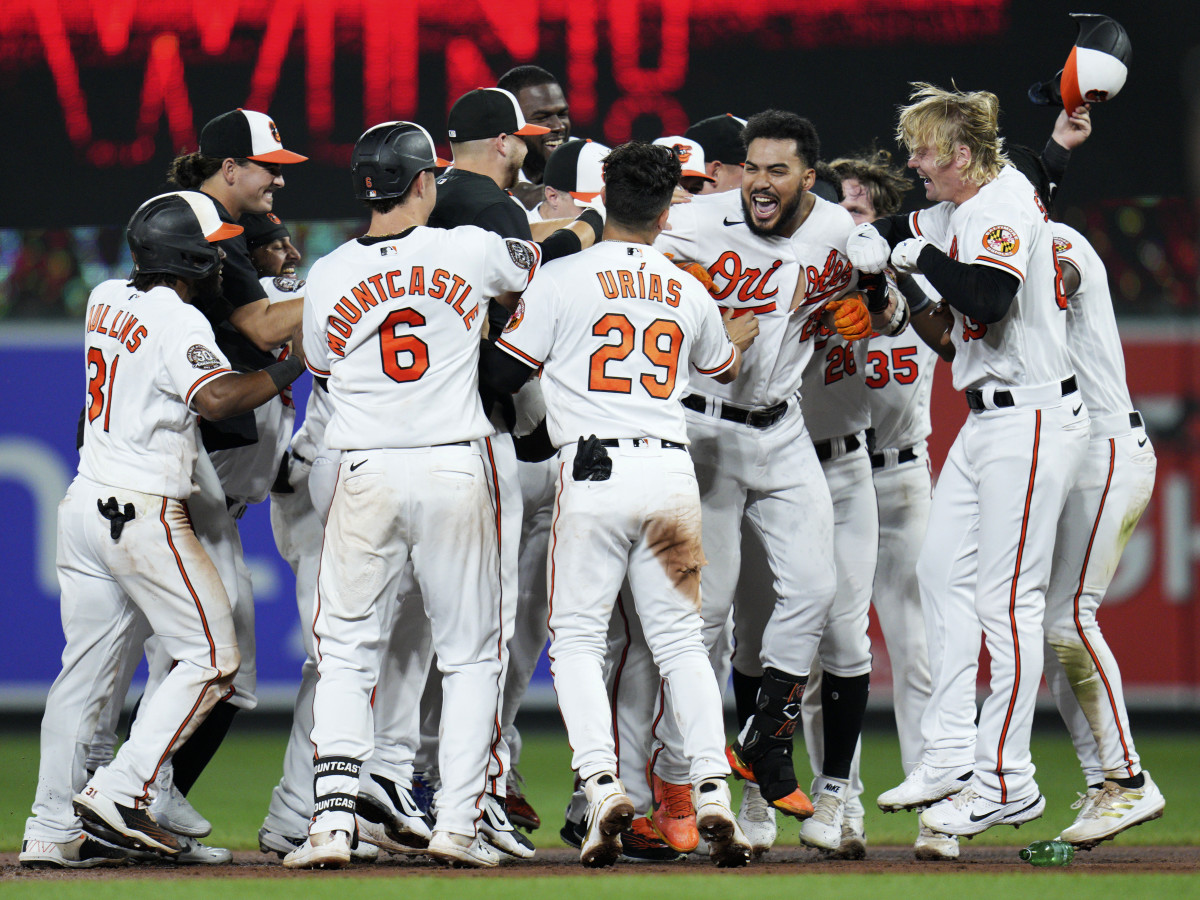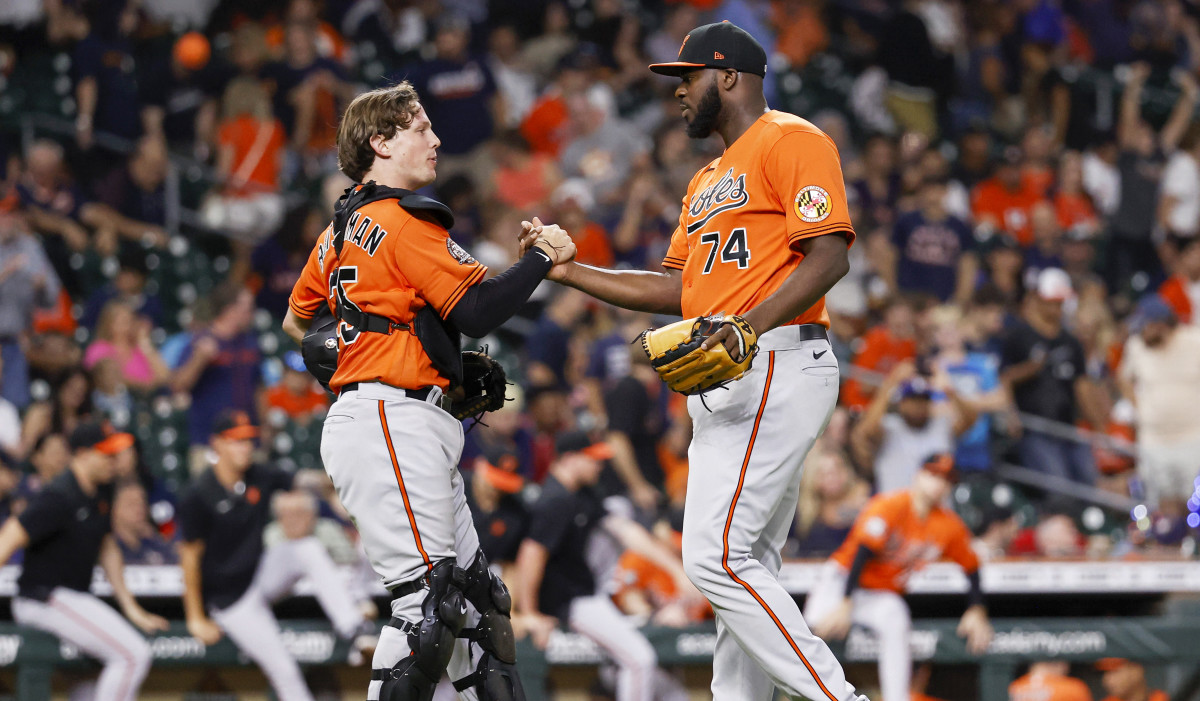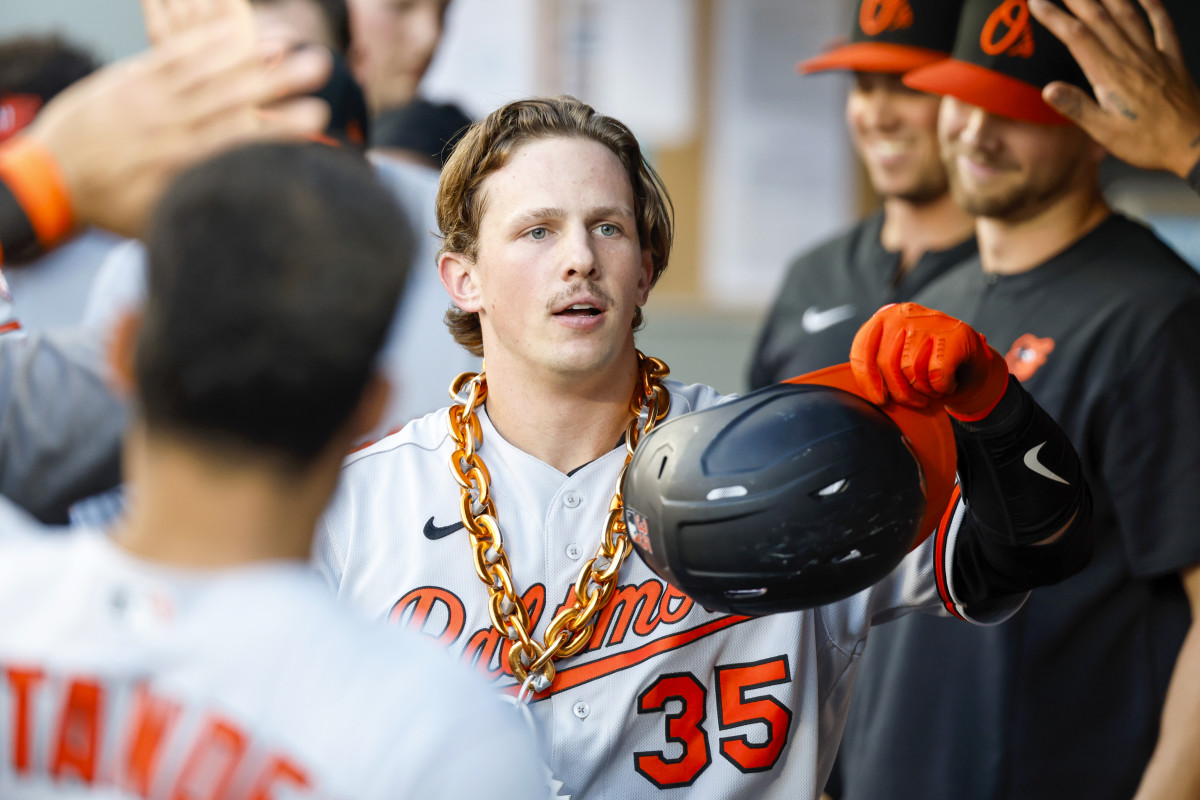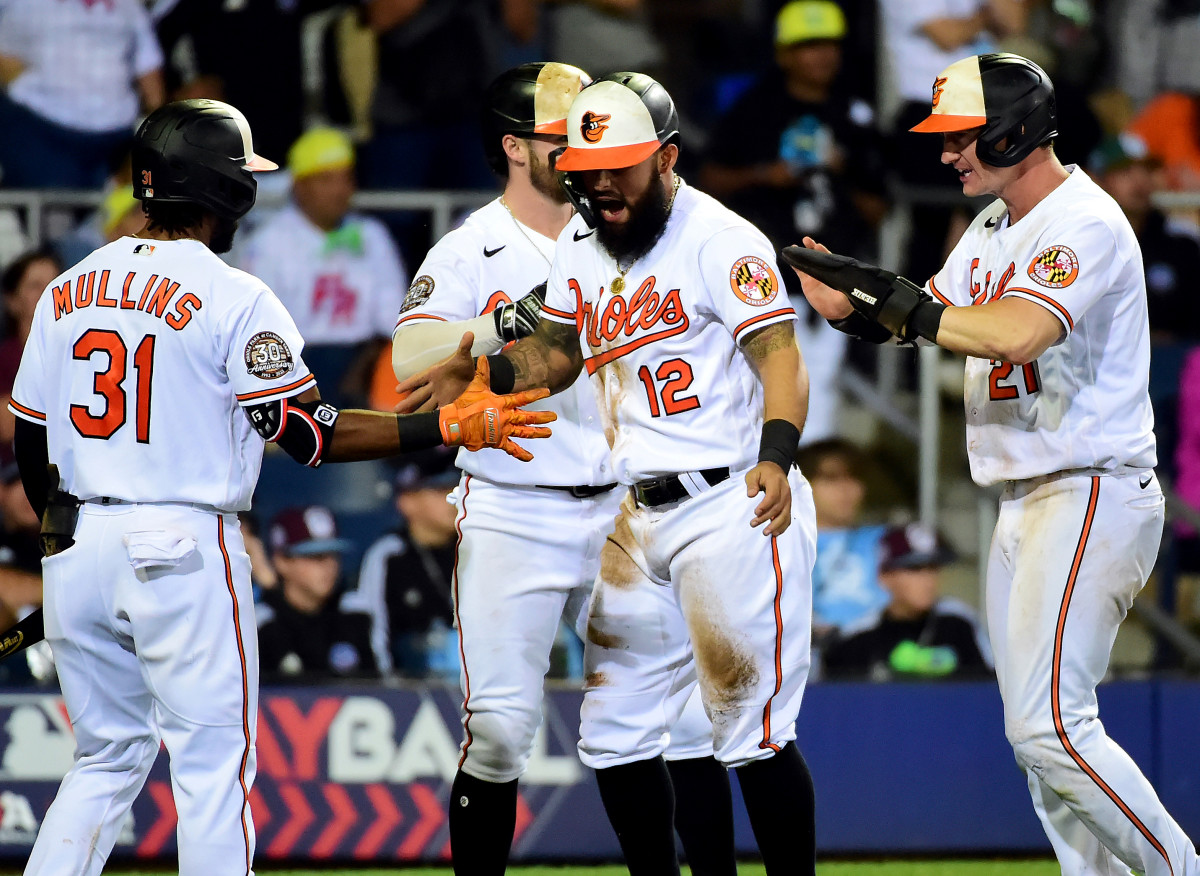How the Orioles Became the Most Unlikely Playoff Contender in MLB History
To the long list of beloved products both fancy and prosaic that succeed because of a secret recipe—baked beans, soft drinks (both Stateside and Scottish), fried chicken, custard tarts, gingerbread, Marmite and fernet, to name a few—you can now add the 2022 Orioles, the most unlikely playoff contender in the history of baseball.
Baltimore lost 110 games last year. With only 35 games to play, the Orioles are 67–60 and just 1 ½ games out of a wild-card spot—just three games out of the first wild card. Nothing like this turnaround has ever happened before. And to make this turnabout more amazing, if not downright quizzical, the Orioles are unspectacularly 18th in runs and 13th in ERA.
“If you look at our stats, you don’t see that we are [seven] games over .500,” says Orioles manager Brandon Hyde. “We’re middle of the road pitching. Middle to bottom hitting. We can be better than that.”
How in the world are these guys doing it? One common explanation has surfaced for this season: “Oriole Magic,” the verbal equivalent of throwing your hands up in surrender to finding any semblance of logic.
Until now.

The answer was found beyond right field at Oriole Park and deep in the catacombs of the B&O Warehouse, which was built in 1899, the same year any team as bad as the 2021 Orioles won more games than they lost the next season. Coincidence? Or something weird at play, such as the ghost of Patsy Tebeau, who like the Orioles, was born in St. Louis?
In a basement warehouse vault installed by architect Ephraim Francis Baldwin, who built churches as well as railroad structures throughout Maryland, Sports Illustrated discovered the secret recipe behind the most unlikely playoff contender in history. Written on a sauce-stained napkin from Boog’s BBQ, the secret recipe of the 2022 Orioles contains these ingredients:
1. Channel Baldwin.
Baldwin didn’t just build any old warehouse. He built the longest brick building on the East Coast—1,116 feet long. After the Orioles posted a 6.00 ERA at home last year, the worst in baseball, they thought big. Really big. They moved the left-field wall back 26.5 feet and almost doubled its height to 13 feet, instantly transforming Camden Yards from a hitter’s park to a pitcher’s haven. It’s ridiculous. MLB should never allow a team to make impossible one of the sport’s great plays, the home-run-robbing catch. But it works for the home team.
Baltimore has lowered its home ERA to 3.42, the 10th best in baseball. Orioles pitchers have improved their overall strike rate from 63.1% to 64.5% and the percentage of their pitches thrown when ahead in the count, from 28% (26th in MLB) to 30% (13th).
“I definitely think it has given our pitchers the confidence to throw the ball more over the white of the plate,” Hyde says. “And I think we have better pitching this year, too. We’re way more talented in the bullpen and our rotation has done a better job. We have better stuff in the bullpen.
“But the ballpark has allowed our guys to be more aggressive in the strike zone than before. And that was something we preached. And we talked a lot about this offseason. To pitch behind in the count, especially in our division, especially in this ballpark, against the lineups we face, you’re asking for a 6 ERA, which is what we had.
“Now we focus on getting the ball over the white of home plate, challenging hitters, understanding how important it is to work ahead of the count.”
2. Add Vitamin D.
Defense typically is behind any leap in win totals. The Orioles have jumped from 24th in defensive runs saved to ninth.
“I thought we were going to improve defensively,” Hyde says. “Jorge Mateo playing Gold Glove defense at shortstop was not something I saw coming.”
Mateo, a waiver claim in August last season from the Padres, earned the job at shortstop with his sparkling defense and improved bat.
And that Baldwin Wall in left accentuates a Baltimore strength.
“I think another thing is we have a plus outfielder in left field,” Hyde says, referring to Austin Hays. “You put Cedric [Mullins] out in center and Hays in left and we feel like we have an advantage. We have guys who can really go get it.”
3. Add Adley.
The Orioles were 16–24 when they called up catcher Adley Rutschman. They are 51–36 since then, the third best record in the league.
Like Derek Jeter, Evan Longoria and Buster Posey, Rutschman is such a cool-headed, talented rookie that he quickly became a cornerstone player—the rare rookie that teammates look to in big spots. He is just the 10th AL rookie catcher ever with an OPS better than .800.

4. Look to “The Mountain.”
Félix Bautista is one of the biggest stories of the season. Signed by the Marlins in 2012 when he was 17 and 6’5” and 180 pounds, Bautista was released after throwing just 38 ⅔ pro innings. Well, he did have some control issues: more walks and hit batters (42) than innings.
Nobody wanted him. At age 20, he was out of baseball for 20 months, thinking about independent ball or Japan, when the Orioles signed him in August 2016. Meanwhile, he grew. I mean, he grew. Now 6'8" and 280 pounds, which earned him “The Mountain” moniker, Bautista throws 100 mph with a nasty splitter and punches out 12 per nine innings.
Watch the Orioles with fuboTV: Start a free trial today!
5. Sign cheap veterans who are leaders.
Staff leader Jordan Lyles ($6 million, on his seventh team), second baseman Rougned Odor ($700,000, on his third team, with the Rangers, his first team, picking up most of the $12.3 million due to him) and catcher Robinson Chirinos ($900,00, sixth team) are “glue guys” who are valued beyond their stats.
“What Chirinos and Odor have brought to our team ... coming to the park with good energy, that has been huge,” Hyde says. “I feel like our younger guys have really fed off that. We’re pretty young and talented, and to have some older players, guys who have been through it a little bit, have that energy and have that feeling we can win every night when we come to the ballpark and enjoy doing it, I think that’s been infectious. That’s been huge for us, honestly. It’s a really, really loose, fun dugout.”
6. Mix in rainbow-colored sprinkles.
Sprinkles make a boring ice cream cone fun. Gimmicks do the same for a baseball team over the grind of a season. The Orioles lead the league in gimmicks: the home run swag chain, the goggles sign whenever a player gets a hit (a nod to their love of Call of Duty), the player of the game championship belt presented after each win, the “Robbie’s Playlist” T-shirts listing Chirinos’s 12 favorite sayings (No. 7: “Feeling Sexy Today”) and the Omar Little whistle from The Wire as an über-cool entrance song for Bautista.
“About a month, month and a half into the season is when you really noticed it, how loud and energetic our dugout has been,” Hyde says.

7. Trade your cleanup hitter and closer with two months to play.
Wait, what? GM Mike Elias jettisoned Trey Mancini and Jorge López at the deadline, explaining the analytics did not give his team a realistic shot at a postseason berth. (Remember those middling hitting and pitching ranks?)
To Hyde’s credit, the Orioles didn’t whine about it. They took it as a challenge to show their own GM what they could do, algorithms be damned.
“The Mountain” eased the pain of losing López, as have lefthander Cionel Pérez (signed off waivers from the Reds) and righthander Dillon Tate (the 2015 fourth pick, who has been traded twice). The three relievers are Hyde’s favorite endgame options, with a combined 2.25 ERA.
“Our bullpen has been the backbone of our team this year,” Hyde says. “I think that’s why we’ve done what we’ve done.”
As Red Sox manager Alex Cora said recently, “Now, they have the lead and the game is almost over. … They’re really good, and this is just the beginning.”
Nobody saw this season coming in Baltimore, not even Hyde, especially after he lost his best pitcher, John Means, to a season-ending elbow injury.
“In spring training, we had no idea how our pitching was going to turn out,” he says. “I was nervous about our bullpen. Means got hurt right away. I thought we were going to improve offensively. I thought we were going to improve defensively.
“It was probably a couple of months in, after Adley got here and we started playing some really good baseball and our bullpen was good and I knew López was a legitimate back-end bullpen guy and Bautista and Cionel Pérez and these guys who have really good arms [emerged]. … That’s when I thought, these guys have a chance to be really good.”
Since the 162-game schedule began in 1961, 12 teams have lost 110 games. The biggest win improvement among them belongs to the 2004 Tigers, who added 29 wins to get to 72.
To find the last team to post a winning record the year after losing 110 games you must go all the way back to the 1899 St. Louis Perfectos. There is a secret recipe behind that team, too.
In 1898, the St. Louis Browns of the National League went 39–111, after which the team was sold to the owners of the Cleveland Spiders, the Robison brothers. Dual ownership was permitted back in that day. The Robisons moved their better players on the Spiders, including player-manager Tebeau, to St. Louis and renamed the team the Perfectos. (Stripped of their best talent, the Spiders went 20–134 the next season.) St. Louis also chose cardinal red as the team’s primary color, which is how the Perfectos became the Cardinals a year later.
The 1899 Perfectos finished 84–67, but unlike these Orioles and without three wild cards, they did not contend. The Perfectos were 14 games out by the end of August and wound up in fifth place, 18 ½ games behind the Brooklyn Superbas.
Alas, the honeymoon for Tebeau and the Perfectos did not last. He quit the following August out of frustration with the team’s play. The Robisons named the team’s 4'9" business manager, Louie Heilbroner, as his replacement. His managing career was doomed to fail once he tried to fine one of his players, Mike Donlin, for fighting with umpires. Donlin lifted little Louie with one hand and told teammate John McGraw, “Take the cover off the water bucket, Mac. I’m going to drown this insect of a manager.”
Tebeau died in 1918 by his own hand in a St. Louis saloon. It was two years after Baldwin died at home in Baltimore, which is to say nobody alive has seen anything like what is going on in the ballpark next to Baldwin’s warehouse, which has become as associated with the Orioles as Oriole Park, which opened in 1992.
Elias’s algorithms don’t give the Orioles much of a chance at the postseason. Independent statistical formulas even now have them at about coin flip to make it. (FanGraphs, which gave Baltimore 0.1% playoff odds before the season; those are now up to 8.6%.) It won’t be easy. The Orioles play 10 of their final 14 games against the Astros, Yankees and Blue Jays, all of whom hold playoff positions. Hyde knows he needs a solid second level of relief pitching to get to October. “Getting other guys to be able to pitch in big spots in the sixth and seventh is going to be important,” he says.

But if this unprecedented season has taught us anything, it is to remind us why we love baseball. We don’t love baseball because we know the percentages. We love it because of those times when a player or team defies them. We live not for the known but for the surprises. We live not for algorithms but for explanations as goofy as “Oriole Magic.”
It’s like biting into a custard tart first made by monks at a Portuguese monastery in 1837. The recipe still may be secret, but that only adds to the joy.
More Baseball Coverage:
• Julio Rodríguez Is the Future of Seattle Sports
• The Little League World Series Is 75 and Still Growing
• Most Little Leaguers Dream of the Big Leagues. He Dreamed of Dentistry
• Good Riddance, Arte Moreno. Thanks for Wasting Trout and Ohtani
